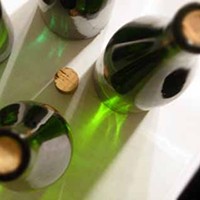Northern Spanish wine country is vast, defined by brown rolling hills with endless dry plains. Like the people, the rugged grapes work hard to achieve success since the wildly fluctuating temperature and minimal rain is far from ideal growing conditions. But there's a small, green, lush region on the northwestern coast called R'as Biaxas [REE-ahse BYEE-shash] in Galicia, where the grapes practically drown in over 50 inches of rain a year. In order to avoid rot, the fruit is hung far above the wet ground, using granite support posts, rather than wood, to support the vine canopies. Albariño [al-bah-REEN-nyo], the finicky, aromatic white grape of the region -- R'as Biaxas only produces whites -- deliciously complements the area's primary cuisine, seafood. Albariño wines, similar in style to New Zealand sauvignon blancs, smell and taste like a fruit salad of green apples, grapefruit and lime.
Ribera Del Duero [ree-BEAR-a del DWEAR-o], a red wine-producing region south of famed Rioja, is quickly becoming the rising star in Spain's fine wine scene. For a long time, grape growers dumped their fruit into the village coop wine vats, creating a wine stew with little or no complexity or character. But about 10 years ago, impoverished and watching the boom in worldwide consumption pass them by, they realized what consumers want -- better value and better wines. Many began bottling under their own name, increasing quality by limiting crop yields -- growing less fruit on the vines to concentrate the nutrients in fewer grapes. Tempranillo, the same hearty, tannic Spanish grape used in Rioja, responds well to these techniques and winemakers also began tempering its robust flavor with cabernet sauvignon, merlot, malbec and garnacha.
Priorat [pree-or-OTT], a tiny, ancient wine region south of Barcelona, is well known to those who collect Spanish wines, but the rest of us have probably never heard of it. The arid, hilly landscape seems foreboding with steep slopes laden with creeping vineyards. Beside them grow thick, gnarled, 900-year-old olive trees, bursting with berries. Since the precipitous inclines reject machines, the grapes (and the olives) must be harvested by hand, making Priorat wine prices a bit steep as well. But neighboring Montsant, a newer region designate, or appellation, boasts better values within its boundaries. The predominant red grapes in both Priorat and Montsant are vastly different than in Ribera and Rioja, starring garnacha and carinea and sometimes syrah, the same grapes in the celebrated French Rhone wine Chateauneuf du Pape. All great stuff.
Yes, after years of slacking, Spain is off its ass. With improved wines and great values, it's high time we declare this country open for business. Exploration might change your perspective, like it did mine.
Recommended Wines
Vionta Albariño 2002 R'as Biaxas One of my favorite Albariño producers and they make plenty of it. Typical Albariño flavors of grapefruit and green apple splash into crisp acidity. $15. 



Fra Guerau 2001 Montsant Cosecha Might be hard to find, but it's here in the States. Elegant with roses, cherry and vanilla that linger on the tongue. Even-tempered and kind to your mouth. Worth much more than its price. $12. 



Latest in Corkscrew
More by Taylor Eason
-

Wines to pair with the feast and fowl
Nov 17, 2009 -

Wineries embrace social media but how well?
Nov 10, 2009 -

Riesling revival: It's one versatile grape
Nov 3, 2009 - More »
Calendar
-

Haw River Wine Tasting @ Carolina Beer Temple.
- Wed., April 24, 5-7 p.m.
-

Haw River Wine Tasting @ Carolina Beer Temple.
-

TRIVIA THURSDAYS!!! @ Elizabeth Parlour Room
-

LIVE MUSIC FRIDAYS: TRACE CASANOVA @ Elizabeth Parlour Room at Hooligans FC
-

Charlotte Grilled Cheese Festival @ SouthEnd Station.
-
How to build a brewery 1
It's not for the Mild
-
Vegan CEO Talks Meatless Mondays and Learning the Lifestyle
Planting the seed
-
Dorie Greenspan's Tiramisu Cake
This layered cake is definitely a "pick-me-up" with a little booze and caffeine.







